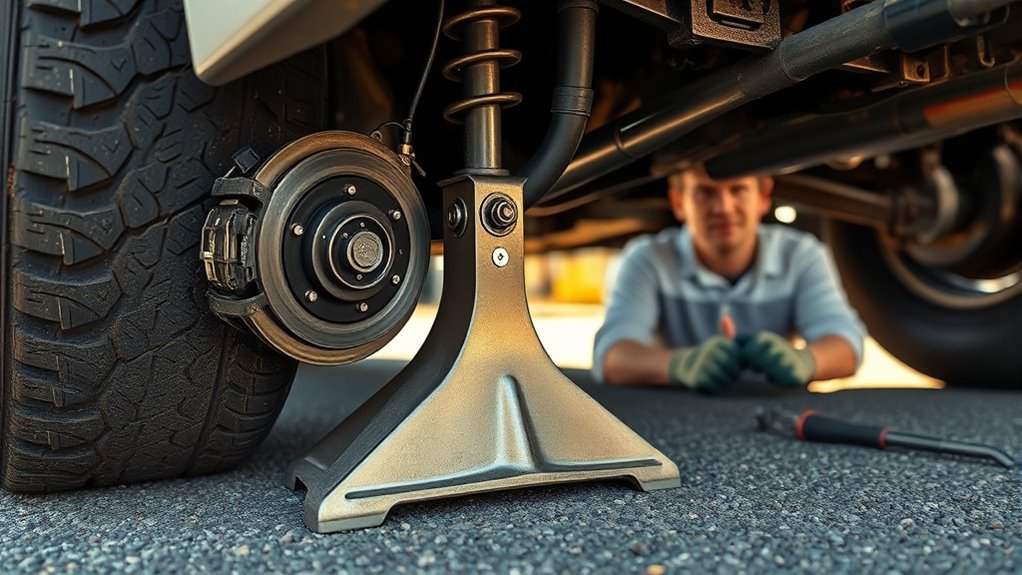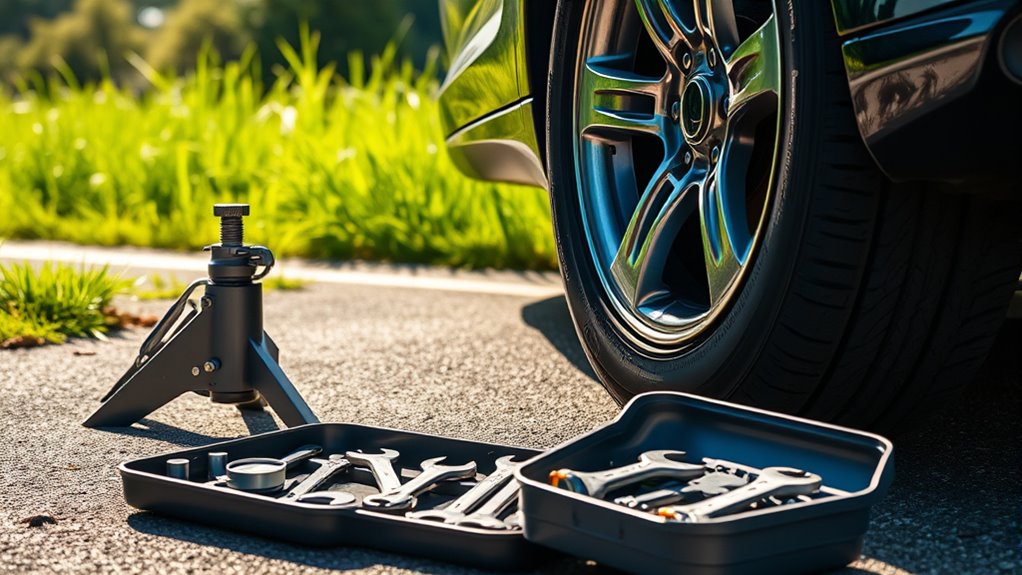When you get a flat tire, start by finding a safe, level spot away from traffic. Turn on your hazard lights, set the parking brake, and use wheel wedges. Use a lug wrench to loosen lug nuts in a star pattern and lift the vehicle with a jack. Remove the flat tire and install the spare, tightening the lug nuts evenly. Finally, check the spare tire pressure and drive cautiously to a repair shop. There’s more to ensure you’re fully prepared!
Key Takeaways
- Find a safe, level area away from traffic to change the flat tire, activating hazard lights for visibility.
- Use a lug wrench to loosen lug nuts in a star pattern, applying body weight for stubborn ones.
- Position the jack at the designated jacking points and lift the vehicle about six inches for clearance.
- Remove the flat tire carefully and align the spare tire with the wheel studs before pressing it onto the hub.
- Tighten lug nuts in a star pattern, check spare tire pressure, and drive cautiously to a repair shop.
Safety First: Preparing to Change a Flat Tire

When you find yourself with a flat tire, your first priority should be safety. Choose a level, straight stretch of road or an empty parking lot, steering clear of narrow shoulders and high-traffic areas. If you’re on a highway, try to reach an exit before stopping.
Turn on your hazard lights to alert other drivers and improve your visibility. Consider using reflective triangles or flares for extra safety. Apply the parking brake and use wheel wedges to stabilize your vehicle.
Always monitor traffic and keep a safe distance from moving vehicles. If conditions feel unsafe, stay inside your car until help arrives. Prioritizing these precautions will help you change your tire efficiently and safely.
Loosening Lug Nuts: Getting Started

With your safety measures in place, it’s time to tackle the flat tire by loosening the lug nuts.
Grab your lug wrench, ensuring it’s in good condition. If your lug nuts are covered by a hubcap, use the flat end of the wrench to pry it off.
Position the lug wrench over the lug nut, extending the handle horizontally for better leverage. Remember to turn counterclockwise.
Loosen the nuts slightly in a star pattern to maintain even pressure. If they’re stubborn, apply your body weight or consider using penetrating oil for rusted ones.
Always ensure the wrench fits snugly to avoid stripping. Don’t rush; gradual force will help prevent damage.
Lifting the Vehicle: Ensuring Stability

To lift your vehicle safely, start by positioning the jack at the designated jacking points outlined in your vehicle’s manual. This prevents damage and ensures stability.
Depending on your tools, use a screw-type scissor jack or a hydraulic jack. Raise the vehicle about six inches off the ground to provide enough clearance for the spare tire.
Always engage the parking brake and shift into park or first gear to secure the vehicle. Place wheel blocks opposite the flat tire to prevent rolling.
Engage the parking brake, shift into park or first gear, and use wheel blocks to prevent rolling.
Once elevated, use jack stands for added support. Remember to keep your body away from the vehicle while lifting, and always maintain control by lifting slowly and steadily.
Safety first!
Removing the Flat Tire: Step-by-Step

After ensuring your vehicle is stable and securely lifted, you’re ready to remove the flat tire.
First, make sure your vehicle is on a level surface and the parking brake is engaged. Activate your hazard lights to alert other drivers. If needed, use wheel wedges for extra security. Gather your lug wrench and any other tools. Refer to your owner’s manual for specific tire removal instructions.
Loosen the lug nuts by turning them counterclockwise, about half a turn, using your body weight if necessary. Remove any hubcaps to access the lug nuts.
Once the vehicle is raised, completely remove the lug nuts and carefully pull the flat tire straight off. Inspect the wheel for debris or damage before storing the flat tire securely.
Installing the Spare Tire: Proper Alignment

Aligning the spare tire correctly is crucial for a safe and effective installation.
Start by positioning the spare tire near the wheel hub, making sure the holes line up with the wheel studs. Once you’ve got it aligned, press the tire firmly onto the hub until it sits flush and centered. This seating ensures that the lug nuts will fit properly.
Next, check that the lug nuts align with the wheel studs before you move on to tightening. Remember, you’ll want to tighten the lug nuts in a star pattern to distribute the pressure evenly.
Proper alignment and seating prevent issues down the road and help ensure a smooth ride until you can get your flat tire repaired.
Finalizing the Tire Change: Ensuring Safety

Finalizing a tire change is crucial for your safety and the performance of your vehicle.
First, check the spare tire’s pressure using a reliable gauge, ensuring it matches the recommended level in your owner’s manual. Inflate it before you hit the road.
Next, tighten the lug nuts in a star pattern with a lug wrench, ensuring they’re secure but not over-tightened to avoid damaging the wheel studs.
Inspect your vehicle for any signs of damage and ensure all tools are stored safely.
Drive carefully to a repair shop, avoiding high speeds and sharp turns. Keep an emergency kit handy and regularly monitor your tire pressure.
Address any tire issues promptly to maintain optimal safety on the road.
Frequently Asked Questions
What Should I Do if My Spare Tire Is Also Flat?
If your spare tire’s flat too, don’t panic.
First, check if you have a tire repair kit or puncture sealant in your vehicle. These can offer a temporary fix.
If not, consider calling for roadside assistance. They can help replace the tire or bring a new spare.
While you wait, make sure you’re in a safe location, engage your parking brake, and use reflective signals to alert other drivers.
Stay safe!
Can I Change a Tire in the Rain?
Changing a tire in the rain can feel like dancing in a downpour, but it’s doable if you’re careful.
Make sure you find a flat, safe spot away from traffic, and keep your tools handy. Visibility’s crucial, so use your hazard lights.
How Long Can I Drive on a Spare Tire?
You can typically drive on a space-saver spare tire for up to 50 miles, but it’s best to keep your speed below 50 mph.
Prolonged use can lead to uneven tread wear and reduced traction, affecting your vehicle’s handling.
What if I Can’t Loosen the Lug Nuts?
When you’re wrestling with stubborn lug nuts, it can feel like a battle against an immovable fortress.
If you can’t loosen them, don’t despair! Try soaking them in penetrating oil or using a breaker bar for extra leverage.
Avoid power tools that could cause damage. If all else fails, heat the lug nuts carefully with a torch, but proceed with caution.
A little patience and persistence can turn that fortress into rubble!
Is It Safe to Change a Tire on a Slope?
Changing a tire on a slope isn’t safe and can lead to accidents.
If you must do it, position the flat tire on the higher side, engage the parking brake, and use wheel wedges to prevent rolling.
Always ensure the jack’s on a stable surface.
If it feels risky, it’s better to call for professional help or move your vehicle to a flat area first.
Your safety should always come first!
Conclusion
With the sun setting behind you, you’ve transformed a flat tire into a story of resilience. You stood firm against the challenge, swapping frustration for triumph as you secured the spare. Now, as you drive away, the road ahead stretches wide and inviting, a reminder that every setback can lead to new journeys. Just like that flat tire, obstacles can become stepping stones, turning a moment of inconvenience into a testament of your resourcefulness. Keep rolling!









